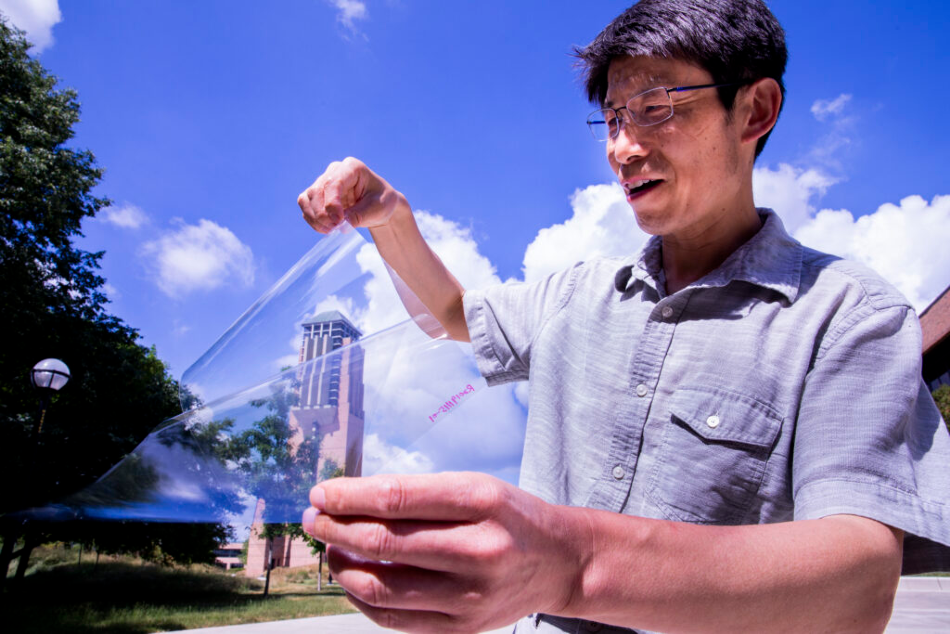Jul 7 2020
At the University of Michigan, scientists have made plastic conductive and more transparent as part of their attempts to enhance window-mounted infrared solar cells, LED light panels, and huge touchscreens.
 Jay Guo holds a sheet of flexible transparent conductor on the University of Michigan’s College of Engineering North Campus. The material sandwiches a thin layer of silver between two “dielectric” materials, aluminum oxide and zinc oxide, producing a conductive anti-reflection coating on the sheet of plastic. Image Credit: Robert Coelius/University of Michigan Engineering, Communications & Marketing.
Jay Guo holds a sheet of flexible transparent conductor on the University of Michigan’s College of Engineering North Campus. The material sandwiches a thin layer of silver between two “dielectric” materials, aluminum oxide and zinc oxide, producing a conductive anti-reflection coating on the sheet of plastic. Image Credit: Robert Coelius/University of Michigan Engineering, Communications & Marketing.
The team has come up with a recipe to assist other scientists to strike the best balance between transparency and conductivity by making a three-layer anti-reflection surface. The conductive metal layer is inserted between two “dielectric” materials that enable light to pass through easily. The dielectrics decrease the reflection from both the metal layer and plastic between them.
We developed a way to make coatings with high transparency and conductivity, low haze, excellent flexibility, easy fabrication and great compatibility with different surfaces.
Jay Guo, Study Lead and Professor of Electrical Engineering and Computer Science, University of Michigan
Earlier, Guo’s group had demonstrated that adding a metal layer onto a plastic sheet to make it conductive was viable—a very thin layer of silver that, by itself, decreases the transmission of light by approximately 10%.
The transmission of light via plastic is comparatively lower compared to that of glass. However, it is feasible to enhance the transparency of plastic with anti-reflection coatings. Guo and his collaborator Dong Liu, a visiting professor at the University of Michigan from Nanjing University of Science and Technology, identified that they could create an anti-reflection coating that was also conductive.
It was taken for granted that the transmittance of the conductor is lower than that of the substrate, but we show that this is not the case.
Chengang Ji, PhD Student, Electrical and Computer Engineering, University of Michigan
Ji is the first author of the study published in Nature Communications and received his doctorate from the University of Michigan in the year 2019.
The dielectrics that were selected by the researchers for this study are zinc oxide and aluminum oxide. On the side nearest to the light source, less light is reflected back to the source by the aluminum oxide compared to the plastic surface.
What follows is the metal layer, which is made up of silver with a small amount of copper in it, with a thickness of just 6.5 nm. It also includes zinc oxide that helps direct the light into the surface of the plastic.
A part of the light still gets reflected back where the plastic comes into contact with the air on the opposite side. However, the overall light transmission is better compared to the plastic alone. The transmittance of light is 88.4%, up from 88.1% for the plastic alone.
From the theoretical outcomes, the researchers expect that other scientists will be able to design similar sandwich-style flexible, highly transparent conductors, which permit even more light to pass through compared to the plastic alone.
We tell people how transparent a dielectric-metal-dielectric conductor could be, for a target electrical conductance. We also tell them how to achieve this high transmittance step-by-step.
Dong Liu, Visiting Professor, Nanjing University of Science and Technology
The trick is to choose the ideal dielectrics and then find the optimal thickness for each to inhibit the reflection of the thin metal. Usually, the material between the metal and plastic must possess a higher refractive index, while the material closer to the light source or display should have a lower refractive index.
Guo has been continuing his efforts to advance the technology, taking part in a project that makes use of transparent conductors in window-mounted solar cells. Such solar cells could absorb infrared light and transform it into electricity while leaving the visible spectrum to illuminate the room.
Guo has also put forward the idea of car windshields and large panel interactive displays that could melt ice similar to the rear windows.
The study was financially supported by the MTRAC Advanced Materials Hub Award. Liu’s visit to the University of Michigan was supported by the National Natural Science Foundation of China.
The University of Michigan has licensed the technology to Zenithnano, a startup company co-founded by Guo, to take up the task of commercialization.
Guo is also a professor of mechanical engineering, macromolecular science and engineering, and applied physics. Currently, Ji is a chief technology officer of another startup based on his PhD work, and Zhang, who was a former PhD from Guo’s lab, is currently a professor at Huazhong University of Science and Technology.
Journal Reference:
Ji, C., et al. (2020) Ultrathin-metal-film-based transparent electrodes with relative transmittance surpassing 100%. Nature Communications. doi.org/10.1038/s41467-020-17107-6.